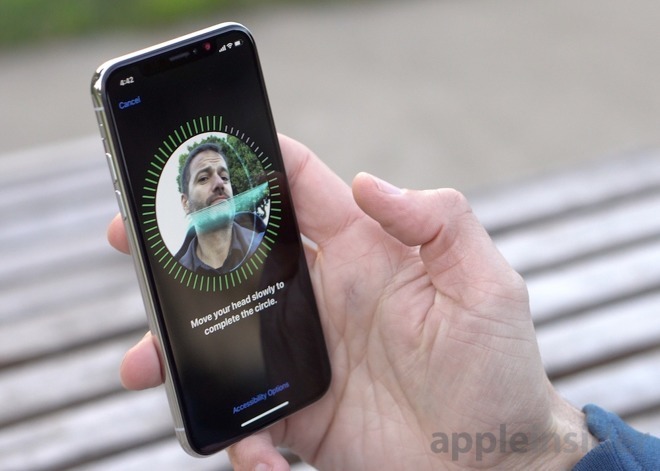Apple could have included a facial recognition system similar to Face ID on an iPhone while retaining Touch ID, with regulatory filings revealing the company did consider having both forms of biometric security on the same device as part of a wider authentication system.
The introduction of the iPhone X in 2017 heralded the introduction of Face ID along with a larger edge-to-edge display, but at the cost of removing Touch ID and the physical home button from the iPhone. While the home button was ultimately removed due to the display and aesthetics, there was still the small possibility ahead of the iPhone X's launch that Apple could use both Face ID and Touch ID on the same iPhone.
A European patent application for "Implementation of Biometric Authentication," filed in January and published on Thursday, describes the use of biometric authentication systems for use on mobile devices. For the most part, the patent discusses how biometric authentication is cumbersome, due to needing to use the device and the identifying section of the body in the same way as the initial registration process for it to be effective.
"Deviation from the alignment of the biometric feature often results in a false negative result," states the filing. "As a result, a user is, optionally, required to unnecessarily perform multiple iterations of biometric authentication, or is, optionally, discouraged from using the biometric authentication altogether."
Multiple attempts at biometric authentication is considered to be a waste of both the user's time and the device's energy, with the patent suggesting more efficient techniques to performing such tests. While a failure would usually require users to reattempt via the same biometric method or to enter their security code, as is the case with current models, the patent application suggests otherwise.
Text buried in the filing mentions the use of an "alternative form of authentication than that associated with the biometric feature." In effect, this means if one biometric authentication check fails, such as Face ID, an alternative like Touch ID could still be used to log in, instead of using the passcode.
The passage suggests that Apple at least thought about including both Face ID and Touch ID mechanisms on the iPhone or iPad before deciding against the prospect.
For users, having multiple biometric systems available would be advantageous in multiple ways. While Face ID could offer authentication while the user's fingerprints are unusable due to gloves or dirt, Touch ID could feasibly be used in situations where Face ID isn't suitable, like in a pocket or if the user is carrying items that prevent them from raising their iPhone to their face.
Apple does file a considerable number of patents and applications on a daily basis, and while the concepts described do indicate areas of interest for the company, it isn't guaranteed the filing's publication will make its way to a consumer product. Considering the successful reception of Face ID as a Touch ID replacement, like the addition of Face ID to the 2018 iPad Pro models, it seems unlikely that Apple will put both authentication systems on a device anytime soon.
Using multiple forms of biometric security on a device isn't new, as other smartphones have already gone down that route with varying results. Samsung has experimented with 2D facial recognition, one that is far less secure than the 3D-based Face ID, but the Galaxy S9 from March also includes more stringent security, in the form of an iris scanner and rear-mounted fingerprint reader, for more sensitive functions like Samsung Pay.
 Malcolm Owen
Malcolm Owen




-xl-m.jpg)


-m.jpg)






 Amber Neely
Amber Neely
 William Gallagher
William Gallagher


 Mike Wuerthele
Mike Wuerthele


 Thomas Sibilly
Thomas Sibilly







34 Comments
As you mention, multiple biometric options give the user advantages. Flexibility is great to have.
It's a shame that a FaceID 'light' wasn't released for the 8 Series.
Using Face ID or Touch ID to authenticate would be less secure. It’s no surprise Apple threw that option out...
Face ID and Touch ID would have been more secure, but the number of false negatives would have exploded... which would have been annoying.
Apple still needs 2FA, but a device with both Face ID and Touch ID would be a pricy and still poor solution.
I understand that there are some edge cases for Touch ID, but after using Face ID for a couple of months I would never want to go back to Touch ID. Face ID simply works so much better and faster than Touch ID, with or without eyewear including sunglasses.
I've had zero issues using Face ID since its implementation...I prefer it much more than Touch ID. I also think it's funny when my grandkids pick up my iPhone X and ask me "what's your password Pop Pop" and I say "it's your face" and they laugh Lol.